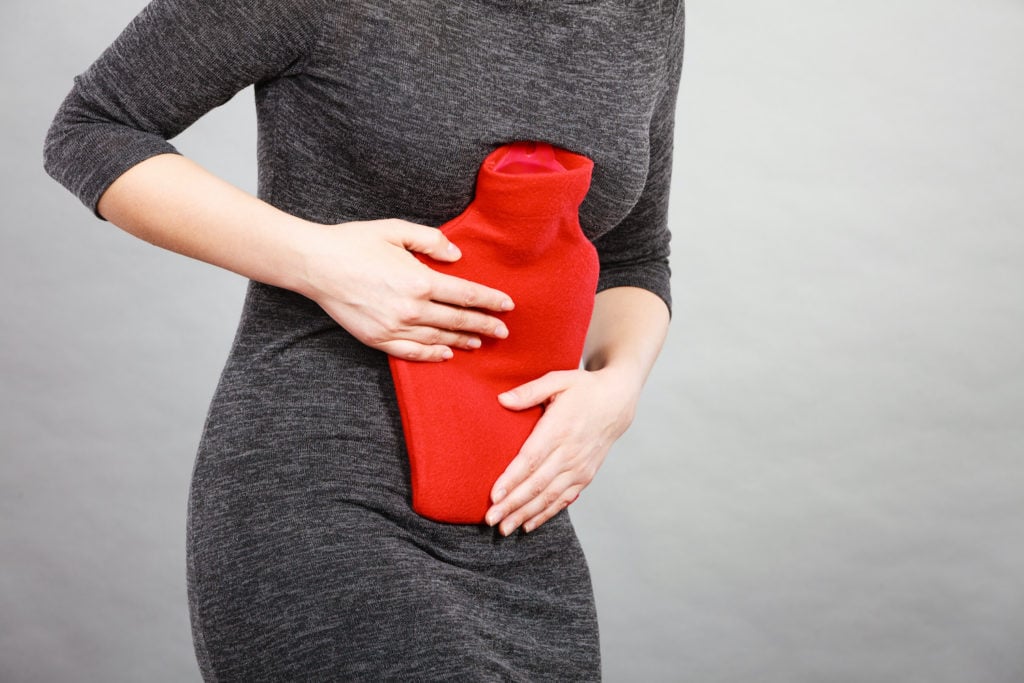Surprisingly Simple Natural Remedies for Menstrual Cramps
How Natural Remedies, Diet, Exercise, and Stress Relief Can Help With Menstrual Cramps
- Menstrual Cramp Symptoms|
- Causes|
- Gut-Hormone Connection|
- Home Remedies|
- Diet|
- Stress Reduction|
- Exercise|
- Natural Remedies|
- Herbs|
- Probiotics|
- Calcium, Magnesium, Vitamin D|
- Fish Oil|
- The Bottom Line|
- Recommended Products|
Download this Episode (right click link and ‘Save As’)
Painful menstrual cramps — also called dysmenorrhea — are one of the most common premenstrual syndrome symptoms, affecting almost half of women of reproductive age.
Conventional cramp remedies like heating pads or hot water bottles, over-the-counter non-steroidal anti-inflammatory drug (NSAIDs) painkillers like ibuprofen, and birth control pills may provide pain relief in the short term, but these are only band-aid measures that don’t address root causes. Fortunately, many natural remedies for menstrual cramps can help.
Let’s discuss painful menstrual cramp symptoms, the causes of menstrual cramps, and how lifestyle solutions, like herbs, vitamins, minerals, a healthy diet, exercise, and stress reduction, can improve your hormonal health and reduce your cramps.

Painful Menstrual Cramp Symptoms
Strong uterine contractions, before or during the menstrual period, can cause painful periods and period cramps. In addition to the cramping of uterine muscles, some women may also experience:
- Bloating
- Lower back pain
- Pelvic pain or pain in the lower abdomen
- Heavy blood flow (menorrhagia)
- Nausea
- An increase in diarrhea or loose stool
- Fatigue
- Cramps or pain when the ovary releases an egg during ovulation.
Some women experience such severe menstrual cramps that they are unable to work or attend school while they are having their period.
Causes of Menstrual Cramps and Period Pain
The root causes of menstrual pain are generally hormonal. There are three main classes of painful menstrual cramps:
- Simple cramps resulting from premenstrual syndrome (more on this below).
- Primary dysmenorrhea is caused by a hormonal imbalance (high levels of prostaglandins) that trigger uterine contractions [1, 2, 3, 4].
- Secondary dysmenorrhea is caused by an underlying disease, disorder, or structural problem within or outside the uterus, such as endometriosis, uterine fibroids, adenomyosis, endometrial polyps, pelvic inflammatory disease, or use of an IUD [1].
The underlying causes of most of these conditions are the results of long-term hormonal imbalances, which are closely related to your gut health.
Simple Natural Remedies for Menstrual Cramps

Alongside a diet that balances blood sugar and stress reduction, several herbs have a long track record of safely supporting hormone health. The best news is that these herbs gently support a healthy hormone balance.
Herbs To Improve Menstrual Cramps
One of the most studied herbs for balancing PMS hormone symptoms is chaste tree berry (vitex). Vitex has been shown to be safe and effective for alleviating PMS symptoms like menstrual cramps [5, 6, 7, 8]. Other herbs with data to support their use include licorice root, chamomile, and fennel [5].
Calcium and Magnesium Improve Menstrual Cramps
Low levels of calcium (and vitamin D) can increase painful periods and menstrual cramps [9]. Women with PMS appear to have lower levels of calcium [10].
Including foods rich in calcium, vitamin D, and magnesium may improve menstrual cramps [11]. This includes dairy products, leafy greens, bone-in canned sardines and salmon, almonds and nuts, and beans and lentils. You can also consider including supplements.
Healthy Fats Improve Menstrual Cramps
A diet rich in well-digested healthy fats is important for your hormonal health because hormones are made from dietary fats [12]. The anti-inflammatory properties of omega-3 fatty acids from fish oil are especially helpful for reducing menstrual cramp pain [13]. Including healthy fats such as olive oil, avocado oil and avocados, fatty fish, or a fish oil supplement in your diet may be a good strategy for improving menstrual cramps.
Probiotics for Menstrual Cramps
Research about taking probiotics for PMS and menstrual cramps is very limited, but we do know that probiotics help calm inflammation in the gut [14, 15, 16], which can reduce your overall stress burden. Probiotics also improve the IBS symptoms that are associated with menstruation, like bloating, abdominal pain, and diarrhea [17, 18, 19].
It’s also been suggested that certain beneficial bacteria [20] may modulate PMS symptoms like cramps. Consider including probiotics in your routine to support your gut and hormone health.
More Natural Remedies for Menstrual Cramps

Your hormones are quite responsive to dietary, lifestyle, and wellness interventions.
Getting menstrual cramps and painful periods under control isn’t rocket science. It just requires paying some attention to your body’s very important needs. Eating for blood sugar balance, reducing inflammation, decreasing stress, and increasing exercise may be all you need to do to get relief.
Diet for Menstrual Cramps: Eat for Blood Sugar Balance
A diet low in processed foods that balances your blood sugar, like the paleo diet, is a great place to start balancing your hormones. Using these four principles of a healthy diet can help.

Blood sugar imbalance is associated with an increase in painful menstrual cramps. Research has found that insulin resistance and blood sugar abnormalities are more common in women who experience PMS [21]. Skipping meals, weight-loss diets, and high sugar consumption are also associated with more severe dysmenorrhea [22].
Research suggests a diet made up of fruits and vegetables, fish, milk, and dairy products are associated with less menstrual pain [22].
You may need to adjust your chosen diet based on your body’s individual needs. Some women experience relief from menstrual pain with a vegetarian diet [23] or including dairy products [24], while others see relief from reducing intake of saturated fat [22]. Be sure to listen closely to your body’s needs. (If you need help customizing your diet, consider meeting with a health coach at our clinic.)
Stress Reduction for Menstrual Cramps
As mentioned above, stress can destabilize your sex hormones, which can contribute to menstrual cramps. Stress can intensify uterine contractions, causing pain [21].
This is especially true if you have high daily stress, poor sleep, or a poor diet during the second half of your menstrual cycle [21, 25].
Two high-quality studies suggest that reducing stress with cognitive-behavioral therapy (CBT) [26] and coping-skills training [27] can improve PMS symptoms like menstrual cramps [26]. Beyond these two specific approaches, simple stress reduction practices like yoga [28], meditation, or time in nature improve stress tolerance. Including at least one stress-relief practice in your daily life is good medicine for improving your painful menstrual cramps.
Exercise Improves Menstrual Cramps
Exercise is widely known to improve general health and menstrual cramps because it releases endorphins and reduces stress. Two systematic reviews found moderate evidence that exercise improves menstrual pain as well as other associated hormonal symptoms such as constipation, breast tenderness, anxiety, and anger [29, 30].
Including regular daily exercise not only helps improve your hormones, but it also balances blood sugar levels [31], improves your mitochondrial function (goodbye fatigue!) [32], and helps you sleep better [33]. Whether this is yoga, running, swimming, or gentle walking, find a way to include daily exercise in your routine.
The Gut-Hormone Connection
Most causes of pain during menstruation are hormonal, and your hormones are impacted by the two-way connection between gut and hormone health.
Gut imbalances, such as bacterial dysbiosis or inflammation from eating processed foods, are experienced by your body as stress. When stress is continuous, your body uses the materials it needs to make sex hormones to produce stress hormones instead.
High levels of stress also increase gut permeability (leaky gut) [34, 35], potentially leading to more stress on your body.
Female hormone imbalance has also been associated with:
- Poor fat digestion [12, 36]
- Imbalances in gut bacteria [20, 37, 38]
- An imbalance of the female reproductive tract microbiome [39, 40]
While your hormones appear to be influenced by your gut health, your gut health also appears to be influenced by hormones. Many women experience IBS symptoms, such as bloating, diarrhea or constipation, or abdominal pain during their menstrual periods, suggesting that IBS may relate to female hormone fluctuations [41].
All of this evidence suggests that keeping your gut in good health stabilizes your hormone levels and can likely help reduce menstrual cycle symptoms like painful menstrual cramps.
Resolve Your Menstrual Cramps With Natural Remedies
Menstrual pain and cramps don’t have to rule your life. If you are noticing regular menstrual symptoms, including painful menstrual cramps, this is a message from your body to pay more attention to your health foundations.
Including hormone balancing herbs and supplements, eating a healthy, anti-inflammatory diet that balances blood sugar, reducing stress, and exercising regularly, can make your periods something to celebrate rather than dread.
And if you feel lost trying to figure out how to put all these steps into practice, please reach out to our clinic to learn about how we can help you balance your hormones.
Dr. Michael Ruscio is a DC, natural health provider, researcher, and clinician. He serves as an Adjunct Professor at the University of Bridgeport and has published numerous papers in scientific journals as well as the book Healthy Gut, Healthy You. He also founded the Ruscio Institute of Functional Health, where he helps patients with a wide range of GI conditions and serves as the Head of Research.



Discussion
I care about answering your questions and sharing my knowledge with you. Leave a comment or connect with me on social media asking any health question you may have and I just might incorporate it into our next listener questions podcast episode just for you!